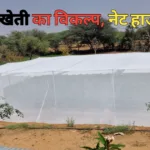In the realm of modern agriculture, where sustainability and efficiency are paramount, innovative techniques like net house farming have gained significant traction. Offering a blend of protection, control, and optimization, net house farming stands as a beacon of agricultural advancement, reshaping the way crops are cultivated worldwide.
What is Net House -Farming?
Net house farming, also known as shade house or screen house farming, is a method of crop cultivation that involves the use of netted structures to create a controlled environment for plants. These structures are designed to regulate factors such as temperature, humidity, and light intensity, thereby enhancing crop growth and productivity.
Types of Net House Structures
There are various types of net house structures employed in agriculture, each catering to specific requirements:
- Shade Net Houses: Utilize shade nets to control sunlight exposure and create optimal growing conditions.
- Fan and Pad Net Houses: Incorporate fans and cooling pads to regulate temperature and humidity levels within the structure.

Benefits of Net House Farming
The adoption of net house- farming offers a myriad of benefits for both farmers and the environment:
- Increased Crop Yield: By providing protection against adverse weather conditions and pests, net houses contribute to higher yields and improved crop quality.
- Protection from Pests and Harsh Weather: The netting acts as a barrier, preventing pests and insects from damaging crops while shielding them from excessive sunlight, wind, and rain.
- Water Conservation: Efficient irrigation systems combined with controlled environments minimize water wastage, making net house farming a sustainable choice.
Key Components of Net House Farming
Successful net house -farming relies on the integration of several key components:
- Netting Material: High-quality UV-stabilized netting is essential for durability and optimal light diffusion.
- Structure and Frame: Strong and durable frames provide stability and support for the netting, ensuring longevity and structural integrity.
- Ventilation Systems: Proper airflow is crucial for regulating temperature and humidity levels within the net house, promoting healthy plant growth.
Suitable Crops for Net House Farming
Net house-farming accommodates a wide range of crops, including:
- Vegetables: Tomatoes, cucumbers, peppers, and leafy greens thrive in the controlled environment of net houses.
- Flowers: Roses, carnations, and orchids benefit from protection against harsh weather and pests.
- Fruits: Strawberries, melons, and grapes can be cultivated with precision in net house structures.
Net House Farming Techniques
To maximize the potential of net house farming, farmers employ various techniques for irrigation, pest management, and temperature control:
- Irrigation Methods: Drip irrigation and misting systems ensure efficient water distribution, minimizing water usage and reducing the risk of soil-borne diseases.
- Pest Management: Integrated pest management strategies, including biological controls and pheromone traps, help to minimize pesticide usage and maintain a healthy crop environment.
- Temperature Control: Evaporative cooling and shade netting are used to regulate temperature and create optimal growing conditions for crops.
Steps to Set Up a Net House
The process of setting up a net house involves several steps:
- Site Selection: Choose a location with adequate sunlight, access to water, and protection from strong winds.
- Design and Construction: Design the net house structure based on crop requirements and local climatic conditions, ensuring proper ventilation and drainage.
- Installation of Equipment: Install irrigation systems, ventilation fans, and other equipment necessary for maintaining optimal growing conditions within the net house.
Maintenance of Net House Structures
Regular maintenance is essential for preserving the integrity and efficiency of net house structures:
- Regular Cleaning and Sanitization: Clean netting and structural components regularly to prevent the buildup of dirt, debris, and pathogens.
- Repairs and Upgrades: Promptly repair any damage to netting or structural components to prevent further deterioration and ensure optimal performance.
Challenges and Solutions in Net House Farming
While net house farming offers numerous benefits, it also presents challenges that require innovative solutions:
- Cost of Installation: The initial investment required for setting up net house structures can be significant, but long-term benefits outweigh the costs.
- Monitoring and Management: Continuous monitoring of environmental parameters and crop health is essential for maximizing yields and minimizing risks.
Case Studies of Successful Net House Farms
Several success stories showcase the transformative impact of net house farming on agricultural productivity and sustainability:
- Case Study 1: A tomato farmer in Spain doubled his yield and reduced pesticide usage by 50% after implementing net house farming techniques.
- Case Study 2: A flower grower in Kenya increased her profits by 30% by transitioning from open-field cultivation to net house farming.
Future Trends in Net House Farming
The future of net house -farming holds promise for further advancements and innovations:
- Technological Innovations: Integration of sensors, automation, and data analytics will revolutionize crop management and optimization.
- Sustainable Practices: Adoption of renewable energy sources and eco-friendly materials will enhance the sustainability of net house farming operations.
Conclusion
Net house -farming represents a paradigm shift in modern agriculture, offering a sustainable and efficient solution for crop cultivation in diverse environments. By harnessing the power of controlled environments and innovative techniques, net house farmers can achieve higher yields, better quality produce, and a brighter future for agriculture.
FAQs
- What are the advantages of net house farming over traditional methods? Net house farming provides protection against pests, harsh weather, and environmental fluctuations, leading to higher yields and better crop quality compared to traditional methods.
- Is net house -farming suitable for all types of crops? While net house farming can accommodate a wide range of crops, suitability depends on factors such as climate, crop requirements, and available resources.
- How does net house -farming contribute to environmental sustainability? Net house farming promotes water conservation, reduces pesticide usage, and minimizes environmental impact by creating optimal growing conditions for crops.
- What factors should be considered when selecting a site for a net house? Site selection should take into account sunlight exposure, access to water, soil quality, and protection from strong winds and pests.
- Can net house -farming be profitable for small-scale farmers? Yes, net house farming can be profitable for small-scale farmers, especially when combined with efficient management practices and market-oriented crop selectlike and







